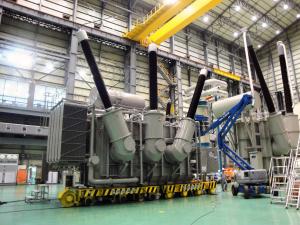US deliveries continue for ITER electrical network
23 Nov 2014
The United States is providing 75 percent of the steady state electrical network components, like this large high-voltage transformer. All of these components have to be installer by October 2015, when the site power demand will exceed the capacity of the temporary 15 kV supply line now in use.
Since September, the US Domestic Agency has been shipping components for ITER's steady state electrical network. High voltage surge arrestors, circuit breakers, switches, current and voltage transformers, substation hardware, control and protection components, and earthing resistors have all reached site successfully and in mid-November, US-procured high voltage substation transformers left Korea for the ITER site after fabrication by vendor Hyundai Heavy Industries.
All of these components are necessary to power up the steady state electrical network by October 2015, when the site power demand will exceed the capacity of the temporary 15 kV supply line now in use.
Because of a well-coordinated team effort involving Princeton Plasma Physics Laboratory (PPPL), the US ITER Project Office at Oak Ridge National Laboratory, URS Corporation and the ITER Organization, the first eight deliveries were completed on schedule.
"This achievement is especially notable because many of the processes and procedures associated with the logistics service provider's delivery of components to the ITER site were exercised for the first time," said Charles Neumeyer, the PPPL-based US ITER team lead for the steady state electrical network.
The United States is providing 75 percent of the steady state electrical network components. The electrical network is essential for supplying conventional power needs at the ITER site, including the pumps and heat exchangers of the tokamak cooling water system and the cryogenic plant that supplies liquid helium to the superconducting magnets. The European Union will provide the remainder of the electrical network hardware and will also handle installation.
During 2015, the United States will also deliver drain tanks for the tokamak cooling water system and toroidal field coil conductors for the magnet systems.


